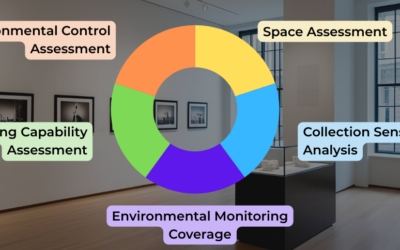At CONSERV we care about collections AND the people who care for collections. In this series of blogs we dive into the stories of some of our favorite customers, what brought them to their current place in their careers, and the unique ways they’re using Conserv.
Like many professionals, Sarah Kortemeier’s life in librarianship didn’t begin with concerns about relative humidity or data loggers. Kortemeier fell in love with libraries as a child because she loved books. In her words, “I was one of those kids who was always at the library. I would check out a stack of books taller than my head every single time I went.”
Sarah’s penchant for the written word led her to the University of Arizona, where she encountered the special collections of the Poetry Center Library as a graduate student in the Creative Writing MFA program. After graduation, Sarah began working at the library, and eventually became the Library Director.
As the leader of a nimble staff of three, day-to-day Sarah wears many hats. She keeps collections development within budget and scope, manages the Library’s education program, and advocates for professors to use the library in coursework. But in addition to her many other tasks, Sarah is also responsible for the everyday care of special collections, as well as planning for the long-term future of the collection. Through this work, she relies on Conserv for her collection’s environmental monitoring needs.
A unique special collection with unique environmental challenges
The Poetry Center at the University of Arizona is extremely uncommon among special collections as one of only three freestanding poetry collecting libraries in the United States. The entire library contains over 80,000 materials—publications from micropresses and independent presses, broadsides related to poetry, photographs of poets, and a large audiovisual archive of poetry readings.

South facade and Entry of the University of Arizona Poetry Center designed by architect Line and Space. Image credit: Henry Tom, CC BY 3.0 via Wikimedia Commons. How do you run a good museum environmental monitoring program with annual monsoon seasons?
Though the Library has been in existence since the 1960s, it moved into a new building in 2007. Despite the fact that the building has a relatively modern HVAC system, the Arizona climate is particularly inhospitable to collections. Arizona experiences a monsoon season annually between June and September. This overlaps with the summer when the university runs on a limited schedule and is even closed at times.
In the summer of 2011, a library volunteer made an offhand observation that when she walked through the rare book collection earlier in the day, it felt cold. When staff went to investigate, they found that the HVAC system had activated, leading to large fluctuations in temperature and relative humidity.
For Sarah, this was a wake-up call, since swings in humidity create mold risk.
She realized that her collections monitoring couldn’t rely on the chance that someone would wander into the collection and notice a change in air temperature.
As an employee in a larger university system, Sarah couldn’t access the data she needed with the environmental system that she had. The malfunctioning HVAC system had sent out alerts, but they were routed to a central computer in the university’s facilities management department.
Sarah needed a solution that was niche-built for museums, university libraries and archival collections, rather than relying on the existing general-purpose systems.
Conserv ensures that monitoring never stops
Sarah looked into other environmental monitoring solutions, but none met her unique needs. Though the Library had instituted daily checks on wall monitors and even obtained a handheld monitor, monitoring could only happen when staff was present. Even small data loggers required periodic downloading of data. Since the staff was offsite on weekends and during university breaks, Sarah needed a system that could communicate alerts to her—wherever she was.
Although Sarah’s situation is unique to a university, offsite collections management is not that unusual, particularly in a world impacted by pandemic conditions. As collecting institutions reopen, they may have limited staff onsite for social distancing. Even in normal times, many collections are spread across buildings and remote locations. And even more importantly— museum professionals deserve days off, even if their “weekends” are Monday and Tuesday!
Before Sarah met Conserv, she had looked into several other systems. Every time she came close to finding a system that would work, she found that it was either too expensive or incompatible with university IT regulations.
She knew that wireless alerts—especially text and email alerts—were what she wanted, and she wasn’t willing to spend money on museum environmental monitoring without this feature.
“Conserv was the only company that came close to doing what I wanted the monitors to do,” said Sarah. As she began looking into Conserv and became a customer, she found the products easy to install and the data accessible.
The environmental monitoring data needed to advocate for collections
As a librarian, Sarah uses her educational programs to advocate for the power of information. In her own work, access to information about the collection’s environmental conditions helps her push for solutions. The entire library is a special collection, even if the rare books are in a vault and the general collections are on the public-facing library floor. Sarah now can track environmental variations on an hourly and daily basis in all the places where collections are stored. For her, preservation is a long-term play. She plans on tracking the data over the next few years, before using it to support an application for a grant for costly, but long-landing, upgrades. She doesn’t yet have the ability to control the collections environment. But, as she said, “I know a great deal more about conditions in our collections, and I’ll use that data to advocate for infrastructure upgrades.”
Sarah believes the input of users has made Conserv’s products better. Instead of other companies that just sell datalogger equipment without real follow-up, Sarah has found the regular recalibrations and communication with the Conserv team to be invaluable.
As someone in a small institution wearing many hats, she doesn’t have the expertise or time to organize a recalibration project. As she told Conserv staff, “We’re a really small shop, we have a million things on our plates, it’s really nice to have you all just handling not only the equipment but the maintenance.”
Conserv empowers Sarah with the data she needs to make big-picture decisions
As Sarah said, “The Conserv system empowers us.” As a Conserv customer for over 18 months, Sarah has seen the long-term success and viability of the product. She believes Conserv is responsive, always taking in the perspective of real users and collections managers and applying them quickly to new updates.
As she said, “Feedback from real collections helps us all. We can all grow and improve together.”
For those working with paper collections, Conserv is an invaluable tool. Paper is extremely sensitive to fluctuations in relative humidity and temperature, and knowing exactly what is happening in the museum environment—even when you’re not there—can help you make decisions.
Sarah’s life as a working poet and library director is busy, and her work takes her in many directions. But wherever she is, she knows where Conserv will be—keeping an eye on her collection and giving her the data she needs to get the job done.
Do you also wish for a supportive and tailored experience for your museum environmental monitoring needs? Reach out to our team!
If you have any questions about environmental monitoring, integrated pest management, or just want to talk about preventative conservation, please reach out to us! Don’t forget to check out our blog or join our community of collections care professionals where you can discuss hot topics, connect with other conservators or even take a course to get familiar with the Conserv platform.




